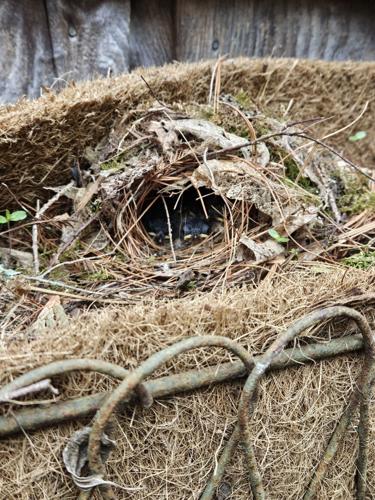We have been watching a pair of Carolina wrens nesting, hatching, and feeding their babies for the last few weeks. The wrens built a beautiful nest out of leaves, twigs, pine needles and moss right outside the bathroom window in a window box that had winter greenery in it. One year they built their nest in a holiday wreath that I had to keep on the door until the baby birds fledged in mid-April! This year, however, it is perfect viewing (and listening since the windows are open) of the pair feeding the babies meal worms, cricket nymphs and various other insects the birds glean from the garden. I feel like they are even beginning to trust me as I stare out the window at them.
Watching all the insects they bring to their nests got me thinking about the real importance of healthy ecosystems. How could the wrens build their nest without leaf litter and moss; how would they feed their babies if no insects were pupating in the garden or in the lawn? Watching the birds do the work to build a bird family is a good reminder to be a good steward of nature. How well do you know your beneficial insects?
We have come to look at all insects as bad, which is far from the truth. We delight over butterflies but likely kill many in the caterpillar stage; we love lady beetles, but the nymph stage looks a little scary; and we swat, and spray ever fly, wasp and bee in earshot. One of the challenges we face when it comes to beneficial insects is that we have a hard time distinguishing between the good guys and the true pests. I recommend adding a book or pamphlet to your garden library that illustrates the insects that we do want out in the garden. And even some we may not, but for the birds.
Beneficial insects are considered such because they prey on garden pests at some stage of their life. This is another consideration when familiarizing yourself with insects: they look different at the different stages of development. Larva, nymphs, and adults do different things to subsist and may look dramatically different then the insect we associate with.
The quintessential example is the braconid wasp. You may be surprised to find that various species of braconid wasps are some of our garden’s best friends. The tobacco hornworm is recognized by many gardeners especially those who love to grow tomatoes. This hornworm is a large green caterpillar with chevron marks of white and black along its back. It can defoliate a tomato plant overnight. Often, we see the hornworm covered in small oval-shaped white cocoons. These are baby wasp cocoons that are feeding on the caterpillar as they develop. And, believe me, there is not much left of the caterpillar once the cocoons have done their thing. The bottom line is this, save those tobacco hornworms so that you have another generation of beneficial braconid wasps in your garden. These wasps lay their eggs on several other pests, as well, including the larvae of other caterpillars, beetles, aphids, and flies.
With names like assassin bug, spined soldier bug, minute pirate bug and big-eyed bug it is not surprising that these beneficials have a reputation in the bug world as being predatory. Lady beetles, ground beetles, damsel bugs, lacewings, flower flies (hover flies) and the mighty bumblebee are all helpers, too. Assassin bugs come in various colors including red and black, green, and brown. Their bodies are flat, thin, and angular and they prove to be voracious eaters of both the adult and larval stage of aphids, beetles, caterpillars, flies, and leafhoppers. The scarab-like ground beetle appears black and slightly iridescent and prefer to lunch on cutworms, fly eggs, maggots, slugs, snails and other soil-dwelling pests like cabbage root maggots and Colorado potato beetle larvae. Lacewings and lady beetles love aphids, thrips mites and scales, among other soft-bodied pests. And the insidious flower bug, also known as the minute pirate bug, uses its long snout to snag the nymphs of leafhoppers, mites, and other small insects.
Reduce the use of pesticides and you increase the population of beneficials; and attract beneficials by planting certain herbs, flowers, and vegetables. Plants that produce generous amounts of nectar and pollen typically attract the good guys. Cilantro, dill, and fennel pull in a great many beneficials. So do borage, lavender, beebalm, Queen Ann’s lace, amaranth, yarrow, and many others.









